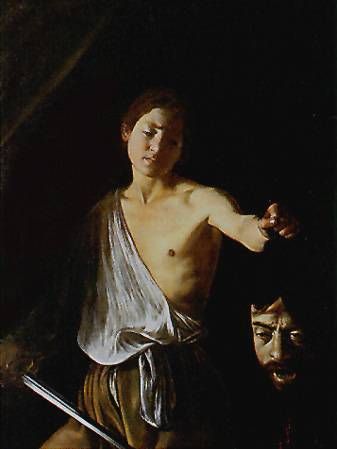Caravaggio/Bacon Exhibition @ Galleria Borghese, Rome
Michelangelo Merisi called Caravaggio, David with the Head of Goliath (1609-10) oil on canvas cm. 125x101. Galleria Borghese, Rome
ROME (REUTERS).- Portraits by Italian master Caravaggio and Irish-born 20th-century painter Francis Bacon stand side-by-side in new exhibition connecting their tormented views of humanity despite contrasting approaches to realism.
The show at Rome's Galleria Borghese marks 400 years since Caravaggio's death and 100 years since Bacon's birth and at its heart lies their shared fascination with the human form and their predilection for the expressive portrait.
Both were radical for their times: against the distorted idealism of high mannerism, Caravaggio was driven by obsessive attention to the real, while Bacon was derided for his refusal to relinquish the human figure in favor of abstraction.
"Bacon can be compared to Caravaggio above all in terms of intensity," said art historian Michael Peppiatt, co-curator of the exhibition and Bacon's close friend and biographer.
Both painters have been seen as icons of gay, tormented genius and their tragic natures and lives marked by violence -- Bacon's lover committed suicide and Caravaggio was condemned to death after killing a man -- are echoed in their works.
"They were both conscious of the shortness of life and of the fragility of humanity, and each powerfully conveys this consciousness through his art," said Peppiatt in a statement.
Seventeen works by Bacon are featured alongside 14 paintings by Caravaggio, six of which, including the "Madonna with the Serpent" and the "Sick Bacchus," belong to the Borghese's permanent collection.
Many of the works by Bacon, including "Head VI," the result of his studies of Velazquez's portrait of Pope Innocent X, are on loan from London's Tate Gallery.
The lavish entrance to the Galleria Borghese is devoted to Bacon's triptychs, painted after the suicide of his lover George Dyer, with chilling scenes of distorted, semi-naked male figures whose life oozes from them to form flesh-colored puddles.
The show runs until January 24, 2010 and has already attracted well over 67,000 visitors, with the record numbers forcing the Borghese to extend its open hours and increase the number of tickets available for the daily tours by 30 percent. By: Ella Ide (Reporting; Edited by Stephen Brown and Paul Casciato)
Francis Bacon, Head VI , 1949 (290 Kb); Oil on canvas, 93.2 x 76.5 cm (36 5/8 x 30 1/8 in); Arts Council of Great Britain, London
Michelangelo Merisi called Caravaggio, Madonna with the Serpent, 1606. Oil on canvas, 292 x 211 cm. Galleria Borghese, Rome
Michelangelo Merisi called Caravaggio, Self-Portrait as Sick Bacchus. c.1593-1594. Oil on canvas, 67 x 53 cm. Galleria Borghese Rome.
Francis Bacon, ‘Study of George Dyer’ (1969)
Michelangelo Merisi called Caravaggio, The Conversion of Saint Paul on the way to Damascus, 1600, Cerasi Chapel, Santa Maria del Popolo, Rome.
Francis Bacon, Three Studies for a Crucifixion, March 1962. Oil with sand on canvas, three panels, 78 x 57 inches (198.1 x 144.8 cm) each. Solomon R. Guggenheim Museum, New York 64.1700. © 2007 The Estate of Francis Bacon/ARS, New York/DACS, London
Michelangelo Merisi called Caravaggio, Portrait of a Knight of Malta. c.1608. Oil on canvas. Palazzo Pitti, Florence, Italy

/https%3A%2F%2Fprofilepics.canalblog.com%2Fprofilepics%2F1%2F0%2F100183.jpg)











/http%3A%2F%2Fstorage.canalblog.com%2F01%2F75%2F577050%2F66348259_o.jpg)
/http%3A%2F%2Fstorage.canalblog.com%2F47%2F53%2F119589%2F62846026_p.jpg)
/http%3A%2F%2Fstorage.canalblog.com%2F17%2F23%2F119589%2F61839898_p.jpg)
/http%3A%2F%2Fstorage.canalblog.com%2F59%2F48%2F577050%2F61815881_o.jpg)